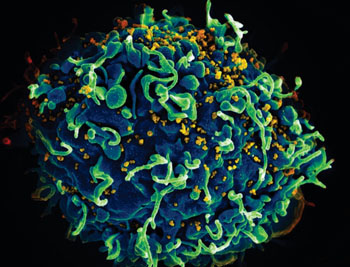Screening Tests Compared to Detect Acute HIV Infection
By LabMedica International staff writers
Posted on 02 Mar 2016
Although acute human immunodeficiency virus (HIV) infection contributes disproportionately to onward HIV transmission, HIV testing has not routinely included screening for acute HIV infectionPosted on 02 Mar 2016
The performance of an HIV antigen/antibody (Ag/Ab) combination assay to detect acute HIV infection (early infection) has been evaluated and compared with pooled HIV ribonucleic acid (RNA) testing, the reference standard.

Image: The human T-cell (blue) under attack by human immunodeficiency viruses (yellow) (Photo courtesy of the US National Institute of Health).
A large team of scientists led by those at the US Centers for Disease Control and Prevention (Atlanta, GA, USA) evaluated the performance of the HIV antigen/antibody (Ag/Ab) combination assay in 86,836 participants in a high-prevalence population from seven sexually transmitted infection clinics and five community-based programs in New York, California, and North Carolina. The multisite, prospective, within-individual comparison study conducted between September 2011 and October 2013 and participants were 12 years or older and seeking HIV testing, without known HIV infection.
All participants with a negative rapid HIV tests OraQuick ADVANCE Rapid HIV-1/2 Antibody Test (OraSure Technologies; Bethlehem, PA, USA) or Clearview HIV 1/2 STAT-PAK assay (Alere; Waltham, MA, USA) were tested for acute HIV infection with the index test, a laboratory-based, fourth-generation immunoassay, Architect HIV Ag/Ab Combo Assay (Abbott Diagnostics; Abbott Park, IL, USA) and pooled human immunodeficiency virus 1 (HIV-1) RNA testing. HIV RNA testing was the reference standard, with positive reference standard result defined as detectable HIV-1 RNA on an individual RNA test. The main outcomes and measures were the number and proportion with acute HIV infections detected.
The investigators found that the HIV Ag/Ab combination assay in place of rapid HIV testing increased the absolute HIV diagnostic yield by 0.15% and diagnosed 82% of the acute HIV infections detectable by pooled RNA testing. Compared with rapid HIV testing alone, HIV Ag/Ab combination testing increased the relative HIV diagnostic yield (both established and acute HIV infections) by 10.4% and pooled HIV RNA testing increased the relative HIV diagnostic yield by 12.4%.
The authors concluded that in a high-prevalence population, HIV screening using an HIV Ag/Ab combination assay following a negative rapid test detected 82% of acute HIV infections detectable by pooled HIV RNA testing, with a positive predictive value of 59%. Further studies are needed to evaluate this strategy in lower-prevalence populations and in persons using pre-exposure prophylaxis for HIV prevention. The study was published on February 16, 2016, in the Journal of the American Medical Association.
Related Links:
US Centers for Disease Control and Prevention
OraSure Technologies
Alere













